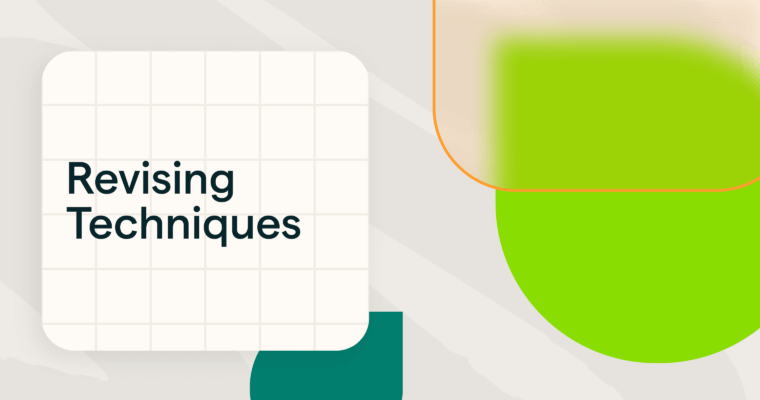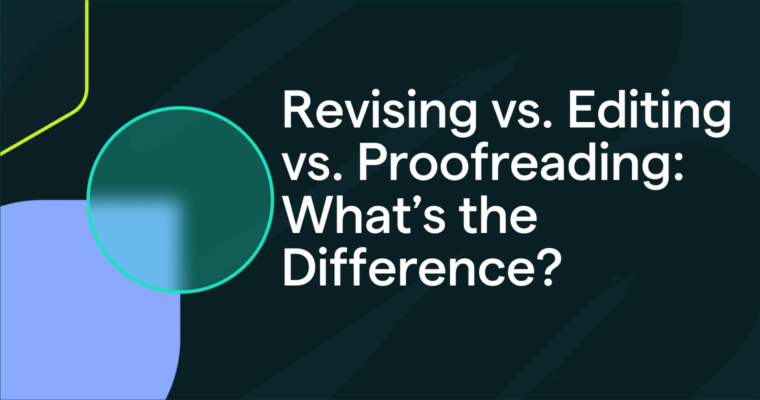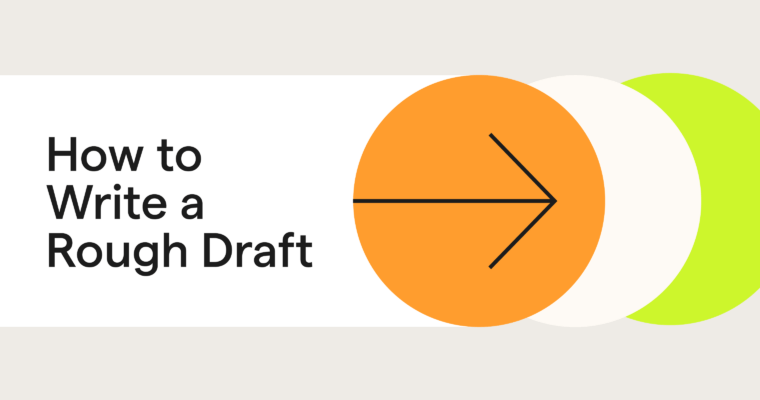
Effective revision isn’t just about reading your draft over and over again. Without a strategy, it’s easy to miss structural issues, lose sight of your main message, or burn out trying to look for every possible improvement. By using targeted revising methods, you can approach your draft purposefully—whether you’re tightening structure, clarifying ideas, or improving the overall flow. These strategies help make the revision process both easier and more effective.
You don’t need to use all of the techniques we’ll discuss. Try one or combine a few to discover what works best for your writing style and goals.
Table of contents
Revising techniques
Revision can quickly become overwhelming if you’re just rereading your draft without direction. It’s easy to get caught making minor tweaks while missing bigger issues—like paragraph structure, logical flow, conciseness, or uneven tone.
That’s where focused revising techniques can help. Trying even one of these approaches can shift how you see your draft, helping you spot what’s working, what’s not, and how to refine it more effectively.
1 Reverse outlining
Reverse outlining is a powerful way to evaluate the structure and logic of your draft after it’s written. To use it, go through your draft one paragraph at a time and write down the main idea of each paragraph—either in the margin or on a separate sheet.
This technique creates a simplified outline of your draft as it currently stands, allowing you to see how your ideas are organized and whether they build toward your main point logically and coherently. It also helps you spot paragraphs that are off topic, repetitive, or out of order.
To reverse outline:
- Write a brief summary or key point for each paragraph in the margin or on a separate sheet to create a simplified outline.
- Review the outline and ask: Does each paragraph support my main argument? Are the ideas presented in a logical order?
- Look for paragraphs that seem off topic, out of order, or repetitive.
Reverse outlining can help you identify gaps in logic, redundant content, or opportunities to strengthen transitions and overall flow.
2 Reading aloud
Reading your work aloud—or using a text-to-speech tool—is one of the most effective ways to catch confusing phrasing, awkward sentence structure, and tone issues.
When you read silently, your brain often fills in missing words or smooths over clunky transitions without you noticing. But hearing your writing forces you to slow down and process each word as your reader would. If you stumble over a sentence, run out of breath, or pause unexpectedly, it’s often a sign that something needs to be clarified or simplified.
What to look for:
- Do you stumble over any sentences or phrases? That may indicate they’re too long, convoluted, or unclear.
- Do your transitions feel abrupt or jarring?
- Does the tone match your audience and purpose?
3 Highlighter method
The highlighter method is a visual revision technique that uses color coding to help you analyze how well your draft is organized and whether each part serves its purpose.
By assigning different colors to elements like topic sentences, supporting evidence, and analysis, you can quickly scan your draft to see if your paragraphs are complete, balanced, and logically structured. This makes it easier to spot missing components, uneven emphasis, or sections that need more development.
To use it:
- Assign colors to different elements:
- Blue = topic sentences
- Yellow = supporting evidence
- Green = analysis or commentary
- Pink = transitions
- Highlight each element throughout your draft.
Then, step back and look for patterns:
- Are any paragraphs missing topic sentences?
- Do you have too much evidence and not enough explanation?
- Are transitions evenly spread out, or are they missing in key places?
This method helps you quickly identify gaps, redundancies, or structural imbalances and can be especially helpful in essays or reports where logical progression is especially important.
4 Cut-and-rearrange method
Sometimes, the best way to see your writing anew is to physically change its form. The cut-and-rearrange method is a hands-on revision technique that helps evaluate your writing’s organization by breaking your draft into parts and refashioning them into experimental structures. It shows how each piece functions individually and together. Rearranging may reveal that background info belongs earlier, an example fits better as a lead-in, or your conclusion should come sooner.
How to do it:
- Use index cards, sticky notes, or digital slides to represent each paragraph or section.
- Move them around freely. Ask: Would this example make more sense earlier? Is the conclusion premature?
- Consider removing or combining repetitive sections for a tighter flow.
This technique makes it easier to rethink how your ideas are organized and whether they’re unfolding in the most logical sequence.
Revising checklist
Once you’ve applied one or more of the techniques above, use this final checklist to ensure your draft is clear, well-structured, and ready for editing or proofreading:
- Is each paragraph focused on one clear idea?
- Is the overall structure logical and easy to follow?
- Do topic sentences and transitions guide the reader smoothly?
- Have I supported my main points with examples or evidence?
- Have I removed any off-topic or repetitive content?
- Are confusing or awkward sentences reworded for clarity?
- Does the tone fit the audience and purpose?
- Have I varied sentence structure for rhythm and flow?
- Did I read it aloud or use a tool to catch hidden issues?
- Have I taken a break before doing a final read-through?
Revising techniques FAQs
What is revising?
Revising is the stage of the writing process where you refine your writing. This stage focuses on improving the content, structure, and clarity of your writing.
What are the benefits of revising?
While the rough draft stage is all about getting your ideas down, no matter how messy, revising gives you the opportunity to strengthen your message, sharpen your tone, and organize your thoughts more effectively. It is where your writing takes shape and your ideas become more focused and impactful.
How is revising different from editing and proofreading?
Revising addresses the big picture—like reorganizing ideas, clarifying arguments, or adding evidence. Editing improves sentence flow and word choice, while proofreading focuses on grammar, spelling, and punctuation. Each step sharpens your work in different ways.
How many times should you revise your writing?
There’s no set number—revision is complete when your writing clearly communicates your message. Most writers benefit from at least two rounds: one for big-picture structure and one for sentence-level clarity. The revision checklist can help you know when you’re ready to stop.
Which revising technique is best for beginners?
Reverse outlining is a great starting point because it helps you understand your writing’s structure and identify major issues. From there, reading aloud can help you catch awkward or unclear sentences.






